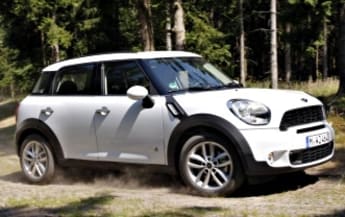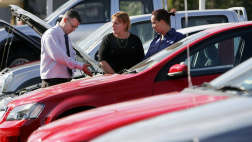The Mini goes maxi with its beefed up Countryman this week hitting Europe's packed small car hatch market. But though Europe's top-selling Volkswagen Golf is in the five-door Mini Countryman's sights, in price and its ability to be tailored to each buyer make it appeal more to the prestige car buyer and, in doing so, ironically, compete with products from its parent BMW.
Mini today said the Countryman, which goes on sale in Australia in January at pricing and final specs still unknown, puts 'clear water' between it and the existing Mini models and claims the bigger hatch will lure a different audience. That may be true. Inside the Mini Countryman uses its 130mm longer wheelbase to offer excellent legroom for the two rear passengers - a three-seat rear bench is available as an option - and its high profile for a tall ceiling height.
It is clearly aimed at the Mini buyer with more than one friend and though rival five-door cars can offer more room in the boot and a cheaper price tag, nothing really spells exclusivity like this latest model. In the flesh, it's big. At 4.1m long it is almost medium size hatch class and that is enforced by its near 1.6m height.
The wheels are 17-inch - though 16s are standard on the base model and 8s are available - and pump out the guards so that, combined with the 'wheel at each corner' design, make it look even more toy-like than the three-door model.

But it is balanced - certainly more so than the asymetrical lines and doors of the Mini Clubman wagon - and attracted curious but not divergent opinion this week.
Part of the reason for the acceptance is that the Countryman is presented as an all-wheel drive. Mini doesn't exactly term it an SUV because it doesn't see it ever being a softroader. Rather, it points to the AWD system - an on-demand system from Haldex - as providing extra traction for those icy or gravel roads that may be an impediment to reaching your favourite ski field or surf spot.
Global car audiences love SUVs and even pseudo-SUVs. Mini says that the Countryman ''bridges the gap between the classic Mini concept and a state-of-the-art Sports Activity Vehicle''.
''The design of the Mini Countryman exudes originality, performance, a dependable robustness and versatility. And yet the customary MINI charm and individual allure remain resoundingly intact.''
There's no new badge to identify the Countryman. Rather, trainspotters will need to pick out the five-door design and if in doubt, will recognise the Countryman's hexagonal-patterned grille that stands more vertical than that of the other Mini models.
The engines will follow existing Mini trends in Australia, with Cooper and Cooper S in diesel and petrol confirmed but Mini says the full John Cooper Works program is unlikely.
Speaking at the Mini Countryman launch in Hamburg yesterday, Mini’s product communications director, Cypselus von Frankenberg, says the bigger model has “more rational appeal’’ compared with the hatchback’s “personal appeal’’. “There’s nothing really that it competes with,’ he says.
He says that people choosing the Countryman – a name borrowed from a 1960s wagon version of the original Mini – would include “loyalists who want to remain with the brand but for lifestyle reasons want more room’’.
He also seeks DINKS (double income, no kids) look at the Countryman because of its all-wheel drive option and as a way of suiting their interests in outdoor pursuits.
“It is a pathway car – it will keep the buyers in the Mini brand for longer,’’ he says. When asked if the Countryman would erode sales of the Clubman – itself a slow seller – Mr von Frankenberg says each has unique appeal.
“It (Clubman) has always been ‘the other Mini’ and is popular in a niche private buyer sector but also with fleets,’’ he says.
“Its appeal is enough for it to stand alone.’’ The car will get a carryover 1.6 normally aspirated and 1.6 turbocharged petrol engine that it shares with the Peugeot 207GTI. But it will get a new turbo-diesel that is from the BMW range.
The 1.6-ltre turbo-diesel is a downsized version of the 2.0d BMW engine used in its 1-Series and 3-Series models. It is more economical that the engine it replaces, cutting emissions below 100g of CO2 per km to 99g/km CO2, and has an average fuel consumption of 3.8 litres/100km, beating the existing engine’s 3.9 l/100km.
Drive
You can dismiss the Countryman as being just another Mini with the same characteristics, charms, idiosyncracies and looks. And, given there is a lot of common components – especially in front of the driver’s eyes – it’s easy to make judgements based purely on aesthetics.
But this Mini doesn’t behave like the other Minis. Thanks to all-wheel drive and different suspension and steering, the Countryman is a superb cruiser that doesn’t mind a bit of dirt under its wheels.
Through fast flowing German traffic, the Countryman – tested only in AWD and with the sweet carryover 1.6-litre turbo-petrol engine – didn’t embarrass its occupants by keeping up with even the quickest fellow travellers.
The six-speed manual was a bit vague which slowed down the shift speed, but when that torque started pouring through from just under 2000rpm it created a swift mid-range tourer ideal for overtaking and with reserves of punch for mid-corner manoueves.
Subtle – yet important – changes have been made to the steering. By comparison with the hatch, the Countryman’s electric assist has better feel and is less likely to find a dead spot just off centre.
Some of this improved feel is due to the all-wheel drive and some to the more rigid chassis that resulted in the stiffening needed to support the AWD components.
The Countryman in AWD (Called ALL4) Cooper S guise weighs 1380kg – 250kg more than the equivalent hatch version – though the extra lard is masked beautifully.
The Countryman has a loping attitude to the road, sprung unusually soft on its long-travel suspension. Even the run-flat tyres (there’s no spare) are compliant and there’s no ill effect on occupant comfort.
The engine is raspy and a bit agricultural at idle when standing outside. Inside the cabin, it’s quiet and will cruise at 140km/h (German autobahn style) in near silence.
The cabin treatment is subdued in terms of colours but typically mish-mash in terms of the layout and design of switchgear and instruments. The central speedo, for example, is too big to read clearly so the digital speed readout in the tachometer – attached to the steering column – is used.
Visibility is reasonable, marred by the tiny rear window and the width of the car, but that affects only the driver. It is, for example, a nice spot for kids to view the passing scenery.
The two bucket seats in the back can be swapped at no extra cost for a bench seat that, ostensibly, will accept three people. In fact, Mini expects a relatively small pick up of this option and sees buyers staying with the intimacy of a four-seat car.
Mini Countryman 2011: Cooper
| Engine Type | Inline 4, 1.6L |
|---|---|
| Fuel Type | Premium Unleaded Petrol |
| Fuel Efficiency | 6.5L/100km (combined) |
| Seating | 4 |
| Price From | $7,920 - $11,220 |
Pricing Guides















.jpg)
.jpg)







.png)










.jpg)

